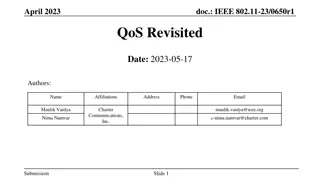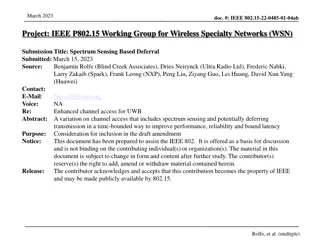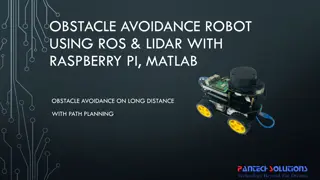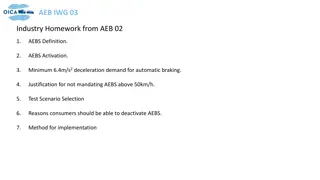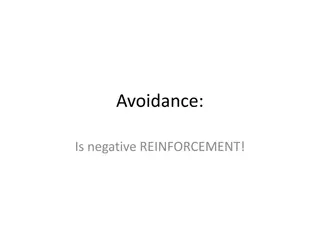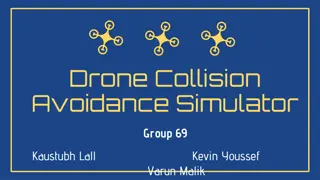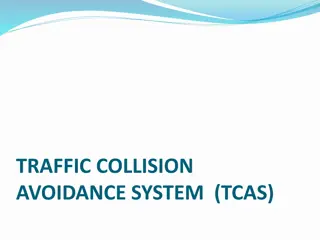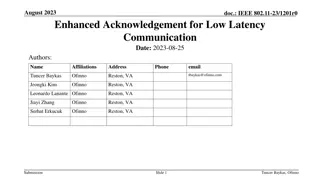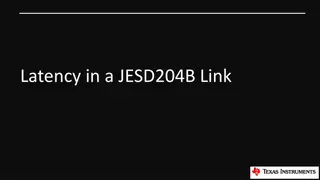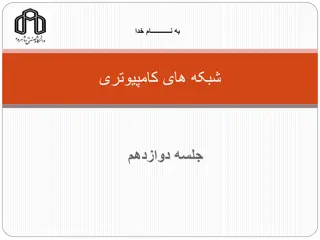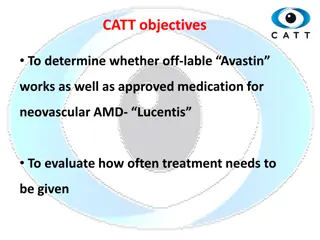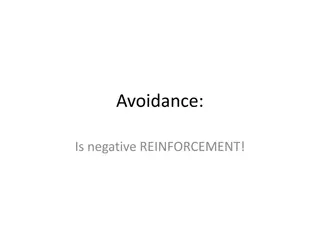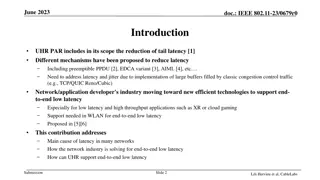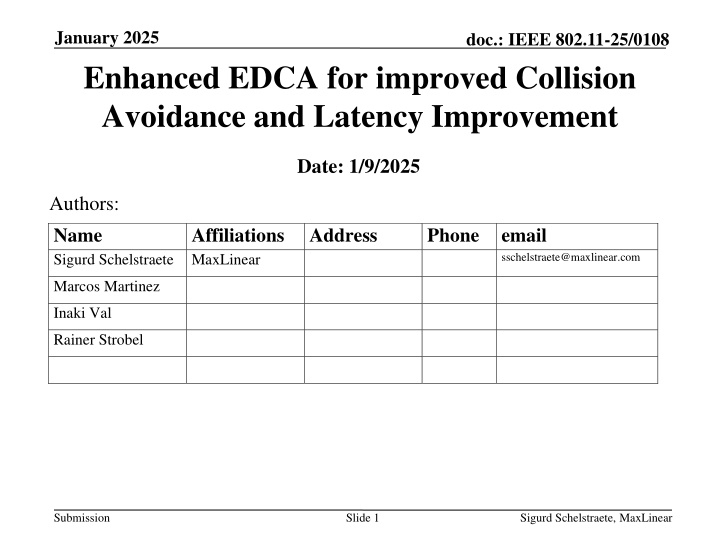
Enhanced EDCA for Improved Collision Avoidance and Latency Improvement in IEEE 802.11-25
Explore the advancements in Collision Avoidance and Latency Improvement with Enhanced EDCA in the January 2025 document presented by Sigurd Schelstraete from MaxLinear. The document outlines a novel channel access mechanism with enhanced collision avoidance, leading to reduced collisions and latency improvements. Details of the method, including iterative channel contention, role of reservation signals, and notes on their implementation, are discussed.
Download Presentation

Please find below an Image/Link to download the presentation.
The content on the website is provided AS IS for your information and personal use only. It may not be sold, licensed, or shared on other websites without obtaining consent from the author. If you encounter any issues during the download, it is possible that the publisher has removed the file from their server.
You are allowed to download the files provided on this website for personal or commercial use, subject to the condition that they are used lawfully. All files are the property of their respective owners.
The content on the website is provided AS IS for your information and personal use only. It may not be sold, licensed, or shared on other websites without obtaining consent from the author.
E N D
Presentation Transcript
January 2025 Enhanced EDCA for improved Collision Avoidance and Latency Improvement doc.: IEEE 802.11-25/0108 Date: 1/9/2025 Authors: Name Sigurd Schelstraete MaxLinear Affiliations Address Phone email sschelstraete@maxlinear.com Marcos Martinez Inaki Val Rainer Strobel Submission Slide 1 Sigurd Schelstraete, MaxLinear
January 2025 doc.: IEEE 802.11-25/0108 Improved collision avoidance In [1], a channel access mechanism with enhanced collision avoidance was proposed Compatible with CSMA and EDCA Includes an additional collision avoidance phase that reduces the number of collisions, to the point where collisions can be almost completely avoided Performance verified through network simulation In [2], the same mechanism was used to achieve latency improvement for selected traffic, even in a highly congested environment Submission Slide 2 Sigurd Schelstraete, MaxLinear
January 2025 doc.: IEEE 802.11-25/0108 CSMA with enhanced Collision Avoidance - recap Submission Slide 3 Sigurd Schelstraete, MaxLinear
January 2025 doc.: IEEE 802.11-25/0108 Essentials of the new method Iterative channel contention over multiple short contention periods Each short round eliminating STAs from contention During the initial rounds of contention, a short reservation signal is sent In [1], [2] an 8 usec L-STF is assumed Only during the last round of contention, the actual PPDU is started STAs are not required to detect collision Submission Slide 4 Sigurd Schelstraete, MaxLinear
January 2025 doc.: IEEE 802.11-25/0108 Role of the reservation signal It is assumed that a short transmission is sufficient for STAs to do PD and recognize the medium as busy Resulting in STAs ending their contention and leaving fewer STAs to contend in the next round 802.11 CCA requires STAs to detect the presence of a preamble within aCCATime The initial rounds of contention add overhead to the Channel Access Keeping the reservation signal as short as possible is important Submission Slide 5 Sigurd Schelstraete, MaxLinear
January 2025 doc.: IEEE 802.11-25/0108 Notes on reservation signal While the CCA requirements appear clear, the kind of signal used as the reservation signal is not a regular 802.11 signal Response of real-world receivers is untested and may not be according to standard expectation Making the reservation signal longer will increase overhead of Channel Access SP requesting definition of a short common signal was not successful [3, 4] Submission Slide 6 Sigurd Schelstraete, MaxLinear
January 2025 doc.: IEEE 802.11-25/0108 New Reservation signal Can the short reservation signal assumed in previous submissions [1, 2] be replaced with a different signal while maintaining the essential advantages? For instance: CTS Shortest possible regular 802.11 transmission (min duration 24 usec) No justification for ignoring CCA based on this signal We ll evaluate the impact of using CTS as the reservation signal Note: content/payload of CTS is not used Doing so may allow for further enhancements Submission Slide 7 Sigurd Schelstraete, MaxLinear
January 2025 doc.: IEEE 802.11-25/0108 1. Collision avoidance Submission Slide 8 Sigurd Schelstraete, MaxLinear
January 2025 doc.: IEEE 802.11-25/0108 1. Collision avoidance Evaluated network throughput as function of number of contending devices (transmitting AC_VO) Using CTS as the reservation signal incurs minor extra overhead, but performs similarly to the original method in avoiding collisions almost entirely (See [1]) Regular EDCA has high residual collision rate in highly congested networks Duration of CTS (min 24 usec, max 40 usec) has minor impact on network throughput Submission Slide 9 Sigurd Schelstraete, MaxLinear
January 2025 doc.: IEEE 802.11-25/0108 2. Latency Reduction [2] showed how a combination of new, more aggressive AC and collision avoidance resulted in a AC with very favorable latency characteristics Reservation signal can be replaced by CTS without significantly affecting these results Enhanced EDCA significantly outperforms EDCA Evaluated for various values of N_LL (# of LL devices needing the new latency values) Submission Slide 10 Sigurd Schelstraete, MaxLinear
January 2025 doc.: IEEE 802.11-25/0108 Results for N_LL=1 Submission Slide 11 John Doe, Some Company
January 2025 doc.: IEEE 802.11-25/0108 Results for N_LL=2 Submission Slide 12 John Doe, Some Company
January 2025 doc.: IEEE 802.11-25/0108 Results for N_LL=5 Submission Slide 13 John Doe, Some Company
January 2025 doc.: IEEE 802.11-25/0108 95 percentile values XCA N_LL EDCA STF CTS 1 7.87 2.79 2.84 2 9.78 2.81 2.95 5 12.11 3.30 3.71 Submission Slide 14 Sigurd Schelstraete, MaxLinear
January 2025 doc.: IEEE 802.11-25/0108 Conclusion Enhanced EDCA can be achieved by a collision avoidance phase in the contention where the reservation signal is a regular CTS The method achieves both collision reduction and latency improvement The method should be considered under the enhanced EDCA work item in UHR Submission Slide 15 Sigurd Schelstraete, MaxLinear
January 2025 doc.: IEEE 802.11-25/0108 References [1] CSMA with enhanced Collision Avoidance, IEEE 802.11-24/0773 [2] CSMA with enhanced Collision Avoidance for Low- Latency traffic, IEEE 802.11-24/1482 [3] Low latency, low collision, low power medium access continued, IEEE 802.11-24/1183 [4] tgbn-sept-2024-meeting-agenda, IEEE 802.11- 24/1364r14 Submission Slide 16 Sigurd Schelstraete, MaxLinear
January 2025 doc.: IEEE 802.11-25/0108 BACKUP SLIDES Submission Slide 17 John Doe, Some Company
January 2025 doc.: IEEE 802.11-25/0108 Simulation Details 1 AP, 10 STAs with full-buffer UL AC_BE traffic NLL=1, 2, 5 LL traffic streams 2 Mbps CBR 1500-byte packets MCS 7, NSS=1 PHY rate EDCA, CSMA, ACK, modeled as per 802.11 Submission Slide 18 Sigurd Schelstraete, MaxLinear

